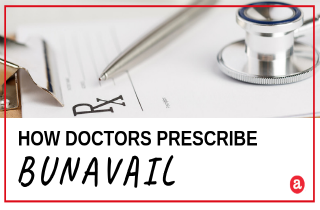Generally, Bunavail Buccal Film is medication used in the maintenance treatment of opiate or opioid dependence. It contains two main active ingredients: buprenorphine and naloxone. Bunavail has shown best results for patients when used as part of a complete treatment plan, which includes counseling and psychosocial support.
The prescription use of Bunavail is limited under the Drug Addiction Treatment Act (DATA). So, who can take Bunavail and how is it prescribed? Here, we provide basic information on who prescribes Bunavail and who is eligible for Bunavail treatment. Then, we invite you to post your feedback or ask questions in the comments section at the end of the article.
Who can prescribe Bunavail?
Prescription of Bunavail in the treatment of opioid or opiate dependence (think heroin addiction or problems with hydrocodone/oxycodone/codeine) is limited to qualified physicians who meed certain requirements. These medical professionals have been certified by the HHS – the Secretary of Health and Human Services – that they will be prescribing Bunavail for the treatment of drug dependence. Medical doctors are required to include a unique identification number on every given prescription, assigned by the HHS.
Bunavail prescription dosage and use
Bunavail is a buccal film, which means it’s administered by applying the film to the cheek on the inside of the mouth and waiting for it to dissolve. It should be prescribed in consideration of the frequency of doctor’s visits. Multiple refills should not be allowed without appropriate follow-up visits or in early addiction treatment.
Since Bunavail is prescribed as a maintenance treatment and the target daily dose is 8.4/1.4 mg, Bunavail is taken at once. The dosage should be progressively increased or decreased, until a dose that fits the individuals needs, keeps patients in treatment and suppresses opioid withdrawal symptoms is reached. Bunavail maintenance doses usually range between 2.1/0.3 mg buprenorphine/naloxone and 12.6/2.1 mg buprenorphine/naloxone per day.Bunavail is available in three different strengths:
- buprenorphine/naloxone 2.1 mg/0.3 mg buccal film
- buprenorphine/naloxone 4.2 mg/0.7 mg buccal film
- buprenorphine/naloxone 6.3 mg/1 mg buccal film
Bunavail prescriptions for addiction treatment
Whether someone is using or abusing prescription opioids (morphine, hydrocodone, oxycodone) or illicit opioids (heroin), addiction to these substances is characterized by the inability to stop using despite being aware of the negative consequences. The role of medications in treating addiction to opiate drugs is to reduce the health risks and damages, as well as the social consequences and improve the lifestyle, well-being and social functioning of recovering patients.
NOTE: Keep in mind that Bunavail is a Schedule III controlled substance, which means that it has a potential to be abused by patients. Bunavail can cause dependence, so withdrawal symptoms are experienced when dosages are lowered or discontinued.
Bunavail prescribing information: PRO’s and CON’s
To help you make up your mind about whether or not Bunavail is right for you, we have compiled a list of the PLUSES and MINUSES of using this medication. Of course, we encourage you to talk to your prescribing doctor and treatment provider to get a better understanding of the course of treatment, expected outcomes, and possible side effects.
+ PRO’s for using Bunavail
- enables patients to engage in therapy and focus on recovery
- encourages the development of healthy behaviors necessary to achieve long-term sobriety
- helps users get the most out of their treatment and counseling
- lowers chances for relapse by blocking cravings
- supports recovering individuals in implementing long-term and positive life changes
- suppresses the debilitating symptoms of opioid withdrawal
-CON’s for using Bunavail
- can be abused in a similar manner to opioids
- chronic use causes opioid type physical dependence
- dangerous if mixed with benzodiazepine drugs or depressants; can lead to respiratory depression and death
- misuse can result in syndrome
- not recommended for patients with hepatic impairments or injuries
- possible adverse side effects
Prescribing Bunavail and information you need to know
When you and your doctor decide that you can benefit from Bunavail and you are given a prescription, there is some important information your doctor should tell you. More specifically, your doctor should:
1. Warn you that the use of benzodiazepines, alcohol, sedatives, tranquillizers or other central nervous system (CNS) depressants can be extremely dangerous while you are on Bunavail treatment.
2. Point out that Bunavail may impair your mental or physical activities and warn you that you should be cautious about driving, operating machinery or performing other potentially dangerous tasks.
3. Provide clear instructions about the time, dosage and schedule of Bunavail buccal film administration and use.
4. Inform you that Bunavail can cause physical dependence and that withdrawal symptoms may occur if doses are suddenly lowered or completely discontinued.
5. Ask you about the full list of prescription medications, over-the-counter medicines, herbal preparations or other substances that you are currently using. This way, possible drug and food interactions can be avoided.
6. Give you a list of all side effects from Bunavail and instruct the best course of action if you experience such reactions. Possible side effects include:
- allergic reactions
- breathing problems
- constipation
- headaches
- insomnia
- nausea and vomiting
- profuse sweating
Bunavail prescription questions
Are you thinking about using Bunavail as a part of your addiction treatment program, or do you know someone who can benefit from it? Ask an addiction professional or a doctor for more information and for medical assessment of whether or not you can benefit from Bunavail maintenance treatment.
You can also post your questions and comments in the section below and we’ll try to provide a personal and prompt answer to all legitimate inquiries.









Related Posts